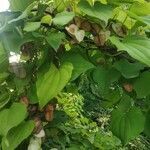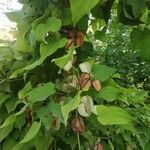Rhizome horizontal, ginger-shaped, 1.2--1.5 cm thick. Stem twining to left, drying light brown to purplish brown, grooved. Leaves alternate, simple; petiole 4--10(--15) cm; leaf blade drying gray-green, triangular or triangular-ovate, usually 3-lobed, 5--9 × 4--5.5 cm, adaxially glabrous, abaxially papillose-setulose along veins, basal veins 3--7, outermost ones much shorter, base shallowly cordate (with very broad sinus) to subtruncate, apex of middle lobe acuminate, apex of lateral lobes rounded. Male spike solitary, sometimes branched, 9--16 cm. Male flowers: solitary or paired, sessile; bracts broadly ovate, membranous, apex acute; perianth saucer-shaped, 3--3.5 mm in diam., lobes ovate, ca. 0.8 mm wide; stamens 6, inserted at base of perianth, anthers 3 introrse and 3 extrorse, connectives not fork-shaped. Female spike to 5 cm, 4--6-flowered. Female flowers: staminodes present. Capsule reflexed, brown at maturity, purplish brown spotted, globose or oblong-obovoid, (1.5--)1.8--2.2 cm, base rounded, apex emarginate or rounded; wings (0.7--)1.2--1.4 cm wide. Seeds inserted near middle of capsule, ovate, winged all round. Fl. May--Jun, fr. Jun--Sep.
More
A yam. It is a climbing herb. The rhizome lies horizontal and is ginger shaped. It is 1.2-1.5 cm thick. The stem winds left. The leaves are alternate. They are 6-12 cm long by 5.5-10 cm wide. They are broadly oval to heart shaped. They are long pointed. There are 5-7 veins. The male flowers are single, small and white. The female flowers are single and slender. The fruit is a capsule.
The tuberous root is slightly bitter so it is boiled and mixed with wood ash then cooked and eaten as a vegetable. The tubers are also repeatedly boiled, washed and then baked. They are also dried then boiled. It is also used to make a drink. The tubers are rich in saponins-used as soap.


